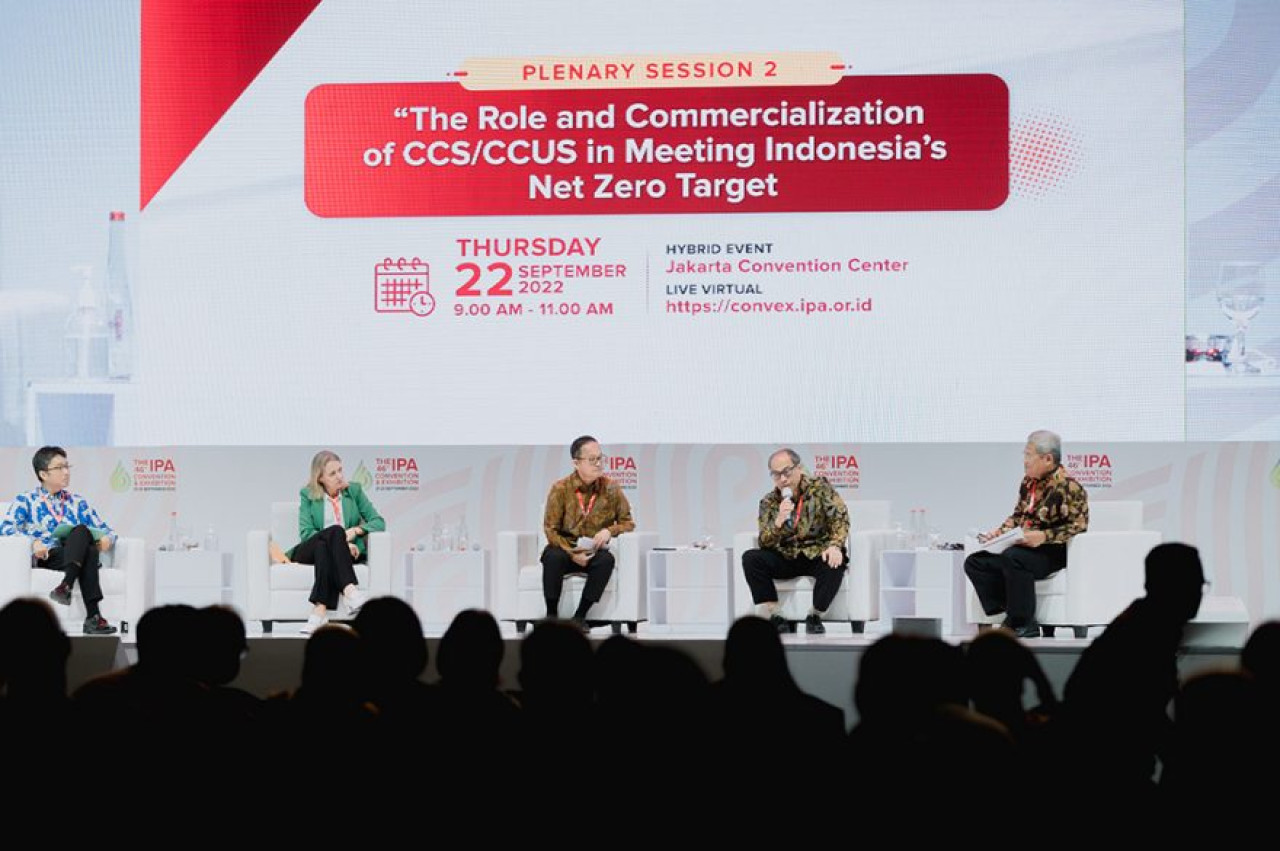CCS/CCUS Technology Plays Important Role in Energy Transition Era
Indonesia’s upstream oil and gas industry seeks to reduce Greenhouse Gas (GHG) emissions from production operations by preparing Carbon Capture Storage (CCS) or Carbon Capture Utility Storage (CCUS). The application of CCS/CCUS technology will help to achieve Net Zero Emission (NZE) 2050 and encourage cleaner oil and gas production.
At the 46th IPA Convention & Exhibition Plenary Session II entitled “The Role and Commercialization of CCS/CCUS in Meeting Indonesia’s Net Zero Target” at the Jakarta Convention Center (JCC) on 22 September 2022, a number of panelists explained the importance of CCS-CCUS on the energy transition. This technology can even reduce carbon emissions by 10 percent globally. However, the implementation of CCS/CCUS needs to be supported by legal certainty, ease of doing business, and fiscal convenience.
Director General of Oil and Gas, Energy and Mineral Resources Ministry (ESDM), Tutuka Ariadji said that Indonesia is in the energy transition stage towards New and Renewable Energy (NRE/ Energi Baru Terbarukan). This energy transition process, said Tutuka, will take a long time. Prior to achieving this, the oil and gas industry still contributes significantly in meeting energy needs. Moreover, gas plays an important role as a transitional energy source with lower carbon emissions.
“The government’s target to increase oil and gas production needs to be supported to meet the increasing national energy demand and reduce energy imports. Such efforts will require new investment and global capital,” said Tutuka.
Tutuka added that CCS/CCUS is an important technology in the energy transition period. This is because the technology can support emission reductions in various industrial sectors.
“The current application of CCS technology is similar to the beginning of LNG exports in the early 1970s, when only a few countries applied the technology,” said Tutuka.
Indonesia, said Tutuka, is currently conducting studies related to CCS/CCUS. There are 10 CCS/CCUS study points spread throughout Indonesia, both in the oil and gas field, as well as in factories with high emissions. Accordingly, CCS/CCUS in Southeast Asia is targeted to reach 35 metric tons (MT) of CO2 by 2030 and more than 200 MT by 2050.
“Indonesia is blessed with geological wealth. Plus, this technology has not been widely applied in other countries. Indonesia can lead the use of CCS/CCUS technology in the region,” said Tutuka.
Still in the same discussion, CEO of Pertamina Hulu Energi (PHE) Budiman Parhusip emphasized that energy should be available, affordable, and clean—or low in emissions. This is because energy demand is projected to continue to increase in the future in line with economic growth.
In the energy mix scheme listed in the National General Energy Plan (RUEN), the percentage of oil and gas energy is projected to decrease, but it will increase in volume. Therefore, oil and gas still play an important role in supporting energy fulfillment in the energy transition era.
In addition, the supply of oil and gas energy needs to take into account the environmental risks it poses. This is where CCS/CCUS will play an important role as a technology that helps reduce carbon emissions in the midst of pursuing production targets. From a corporate perspective, the development of CCS/CCUS technology can also become a new business area for Pertamina.
“The current technical aspect is to prioritize the development of EOR and IOR to increase hydrocarbon capture and build partnerships for CCS/CCUS builders,” said Budiman.
Budiman said that PHE’s commitment to sustainable development, especially regarding decarbonization, requires strategic partnerships with related parties. PHE, continued Budiman, has committed to protecting the environment, and has formed a committee as well as made policies related to this matter.
Budiman added that currently PHE has built partnerships with companies that have green bonds, and continues to encourage improvements in PSC fiscal governance. “To open this CCS/CCUS, partnerships, value addition, leveraging of existing infrastructure, policy support, and return of profits are needed,” he added.
According to Budiman, capital can be a good start to support the implementation of CCS/CCUS. With good capital, new possibilities related to increasing production, capacity, and meeting domestic needs will be opened. In line with this, PHE intends to increase production. Furthermore, according to Budiman CCS/CCUS is a potential business.
Meanwhile, ExxonMobil’s Vice President of Marketing, Financial & Commercial Development, Tracy Lothian said that efforts to achieve NZE require support for large carbon storage. Relevant stakeholders need to focus on decarbonization efforts in industries that produce high levels of carbon emissions in order to achieve the NZE target.
Tracy also emphasized that policy support is a crucial thing needed for the development of CCS/CCUS in the country. “In particular, stakeholders need to issue a CCS/CCUS commercialization policy,” said Tracy.
The CCS/CCUS project led by ExxonMobil has so far shown positive progress. Tracy explained that the company is currently opening CCS/CCUS projects in various offshore areas of the United States, one of which is located in Houston, Texas.
Meanwhile, VP Director of JETRO, Akihisa Matsuda said that the Japanese Government has set a Net Zero target in 2030, and even has ambitions to reach the Negative Emissions phase by 2050. Through JETRO, Japan is holding a strategic partnership related to CCS/CCUS with a number of Asian countries in the ASIA CCUS Network committee.
“This started in 2020 when the Prime Minister of Japan, Yoshihide Suga released the Net Zero Emissions policy,” said Akihisa.


